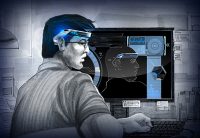Displaying news tagged: brain
Novel Memristor Neuron Circuits Offer Building Blocks for Mimicking the Brain

In an effort to electronically mimic neurons—the nerve cells of the brain—scientists from HRL Laboratories, LLC have successfully demonstrated novel electronic neuron circuits that exhibits as many as 23 known behaviors of biological neurons and the three classes of neuron activation (excitation) that code information between neurons about sensory events, cognitive processes, or motor actions.
All-Memristor Architecture Could Enable Brain-Like Computers

HRL Laboratories, LLC, will leverage electronic brain-cell technology for a new computer architecture that promises more compact, energy-efficient, and capable systems. The program is part of the Defense Advanced Research Projects Agency program Foundations Required for Novel Compute (FRANC).
Computer Modeling Brain Phenomena to Solve Hard Problems

HRL Laboratories, LLC, computer scientists have found that computer models of a phenomenon in the brain called self-organized criticality (SOC) can be used to calculate optimal conditions within complex networks.
Brain Meeting Presentation by HRL Shows Promise for Transcranial Stimulation During Sleep

HRL Laboratories, LLC, was represented at the 3rd Annual Brain Initiative Investigators meeting by Dr. Praveen Pilly, who presented Improving Memory Performance by Augmenting Consolidation with Transcranial Stimulation in the plenary session on “Applications of BRAIN Technologies”.
HRL Demonstrates the Potential to Enhance the Human Intellect’s Existing Capacity to Learn New Skills

Dr. Matthew Phillips and his team of investigators from HRL’s Information & System Sciences Laboratory used transcranial direct current stimulation (tDCS) in order to improve learning and skill retention.